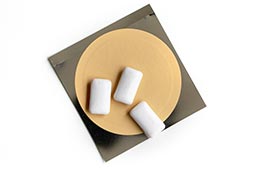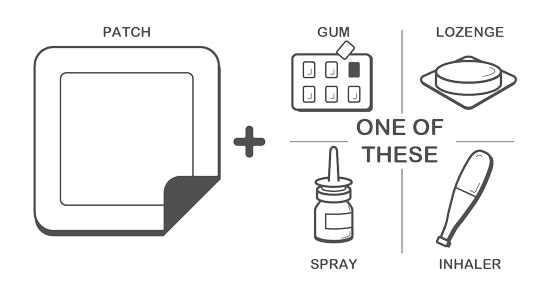How to Combine Quit Smoking Medicines
There are seven medicines approved by the Food and Drug Administration (FDA) to help you quit. They work in different ways. All have been shown to be safe and effective for adults who smoke cigarettes.
These quit-smoking medicines include nicotine replacement medicines (the nicotine patch, lozenge, gum, oral inhaler, and nasal spray) and pill medicines (varenicline and bupropion SR).
Some other strategies, with or without medicines, can help you quit as well.
You can use some quit-smoking medicines together for a better chance of staying quit. For example, long-acting nicotine patches can be used with shorter-acting nicotine gum OR lozenge to control withdrawal symptoms and the urge to smoke.
Using combination NRT starts with putting on a patch each morning to get a steady level of nicotine all day. Then you also use a nicotine medicine like the lozenge or gum that works more quickly to help deal with urges or cravings when you feel them coming on. You can also talk with your healthcare provider about other combinations of quit smoking medicines that may improve your chances of quitting for good.
- You can use some quit-smoking medicines together for a better chance to quit smoking. Quit-smoking medicines work in different ways to help ease withdrawal symptoms and lessen cravings. For example, you can use a long-acting nicotine replacement medicine together with a short-acting one:
- Long Acting: The nicotine patch is referred to as “long acting” because it provides a slower, steady level of nicotine over a long period of time. It can be helpful by providing a steady state of nicotine throughout the day to help ease withdrawal symptoms.
- Short Acting: The nicotine gum, lozenge, nasal spray, and oral inhaler are referred to as “short acting” because they give you nicotine more quickly. Short acting medicines can be used to help you get through cravings, or even in anticipation of a craving.
- Quitting smoking may make some people depressed or anxious, whether quitting with medication or not. Get help if you have feelings of depression or anxiety that last for more than two weeks or that get worse.

No product endorsement implied.
- Start the patch in the morning, as directed.
- Use a short-acting form of quit-smoking medicine (like gum or lozenge) as needed and as directed for breakthrough cravings.

Combine quit-smoking medicines as follows:
| Long acting: | Short Acting: |
|---|---|
| Nicotine gum OR |
|
| Nicotine Patch + | Nicotine lozenge OR |
| Nicotine nasal spray OR |
|
| Nicotine oral inhaler |
Talk with your doctor or other healthcare provider about other combinations of quit-smoking medicines that may improve your chances of quitting for good.
- Using two nicotine replacement medicines (NRTs) together is more likely to help you quit successfully than using one alone.
- Patch will reduce your withdrawal symptoms throughout the day while lozenge or gum will quickly help deal with any breakthrough cravings.
- You control how often you use the lozenge or gum, so you won’t get more nicotine than you want.
- You have added flexibility lowering the amount of nicotine you get when you are ready to stop using NRT.
- May be able to use a lower dose or amount of lozenge or gum than you would if you were using them without the patch.
- Available without a prescription (over-the-counter).
- If you are paying for the medicines yourself, using two medicines will cost more than using one.
Possible Side Effects (and what you can do about them):
- You can get the same side-effects using combination NRT that you get from the individual medicines (you can try lower doses to minimize side effects).
Precautions:
- Before starting combination therapy, check out the precautions for each individual medicine.